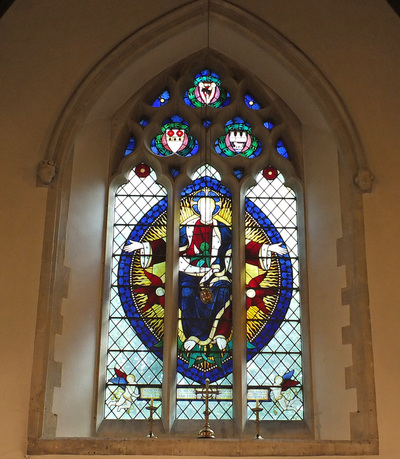
In the early spring, during the weeks leading up to and after Easter light floods straight through the face of the risen Christ in the East Window during the 10 a.m. service, which is a wonderful metaphor created in glass of the light-filled presence that Christ represents in our lives. The window depicts Christ in Glory.
The East Window was installed in 1951 to commemorate the men of the parish who died in the second world war. The words that run along the bottom say: Dedicated in memory of the men of this parish who gave their lives for their country 1939-1945. It was designed by the distinguished church architect Sir John Ninian Comper (1864-1960).
Comper was one of the great church architects and craftsmen of the late 19th-early 20th centuries, a leader in the Gothic revival movement. He was so eminent that his ashes are buried in Westminster Abbey below the window he had designed featuring Henry III. “Some say Comper is all kitsch and Victorian Aryan Christianity,” says one website “but there is much more there, I think – a delicacy, an innocence and a real sense of beauty”. Look at the still, grave features of the Christ in our window, the beautiful symmetry of the composition and chunks of vivid colour. There is a sense of tenderness in the two angels who hold up the scroll at the bottom of the picture, and the medallions of cherubs caught within the scarlet robes on the left and right. Comper’s signature trade mark, a miniature strawberry plant, is tucked away at the bottom right hand corner.
Christ in Glory was a favourite Comper theme: try Googling Little Walsingham, Norfolk to see another example, or the tester in the shrine to St Cuthbert in Durham: the same eternally youthful Christ, the same rays of blazing sunshine encasing the seated figure with arms open in blessing, the same nearly circular oval medallion created in a very few vivid colours.
There are Comper windows in Oxford at St Johns in North Hinksey, All Saints Cowley, and Pusey House. The Pusey House website says that the Comper ciborium over the altar in the Blessed Sacrament Chapel is one of the finest examples of his work; and some of Comper’s original vestments remain in use. Our font was designed by him too.
Above our Christ in Glory are three shields: the top shield represents the Trinity; the ox and three crowned women, on the right, is the crest of the Oxford Diocese; the one on the left is the Nuffield crest. However, it is appropriate that Nuffield’s red roses also symbolise the blood of Christ and traditionally represent the blood of martyrs as this is a war memorial.
Between 1867 and 1950, the Gothic decorated East Window contained the Crucifixion that has now been moved to the Lady Chapel. This small panel was surrounded by clear glass so the impact of Comper’s large image, that reaches into all 21 leaded panels, must have been exciting. The 1951 HT magazine was unimpressed by the Crucifixion, saying it was about time the “drab, uninteresting and inartistic East Window” was replaced with something modern. Comper, whose long career hardly made him modern, was designing in the Gothic tradition blended with classical elements. However, his window for Holy Trinity was certainly radically different from the rest of the Holy Trinity glass until the Narnia window.
The cost was £288 (at a time when the average gross annual salary was about £100). The financial reports for Holy Trinity for the early 1950s were, rather unusually, “exceedingly satisfactory with rising income” records the magazine, which noted that £62 was immediately allocated for the window. It was installed free by two stonemasons who were members of the congregation, Jim Phillips and Morris Man Harry Kimber, helped by his Quarry Morris Men mates, who came at the end of their day to work on it. (Harry Kimber also made the font.) The window was cleaned in 1991 by another member of the congregation, Grant Fryer.
“When you were christened you were always brought up to see the window,” says Richard Butler (a member of our choir whose memory goes back a long way). “On Remembrance Sundays, the church was so packed it was hard to get in; men with flags; women in mourning.” As the HT magazine said at the time: “As a War Memorial it will quietly remind us, too, that men and women are called to share His self-sacrifice, that His Kingdom may come in the wills of men and nations. It will express our faith that such sacrifice is not in vain because He receives it and uses it for the glory of God.”
The window looks magnificent from outside. If you are walking up to the church from the Quarry Hollow end after dark when the church is in use, the lights within blaze through the colours into the night and create a sense of richness and warmth.
